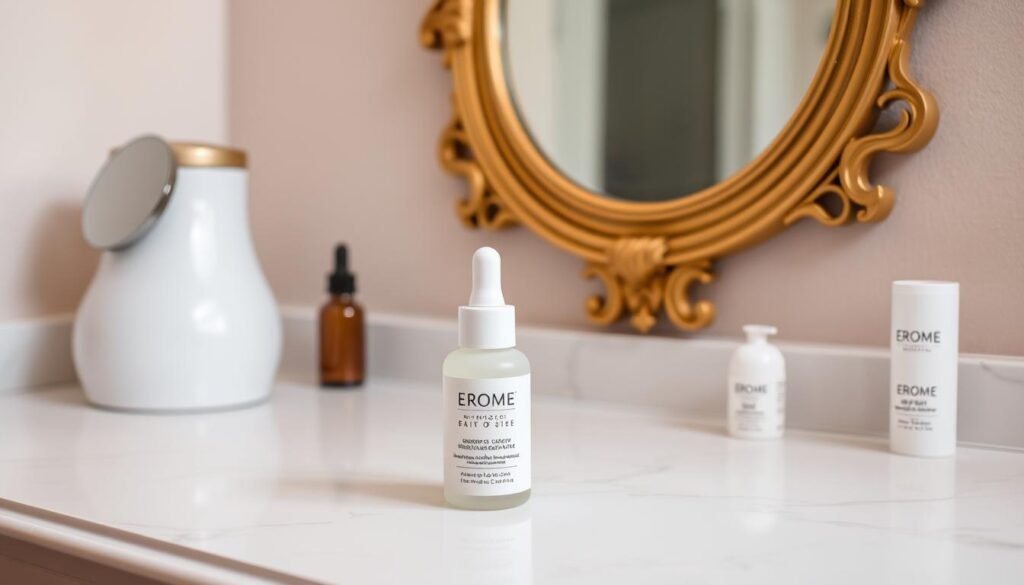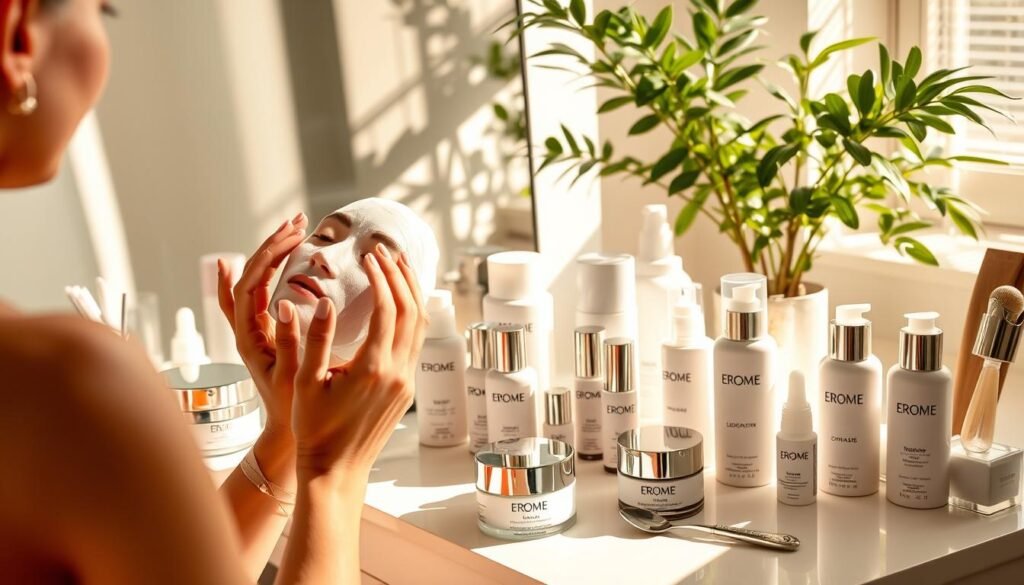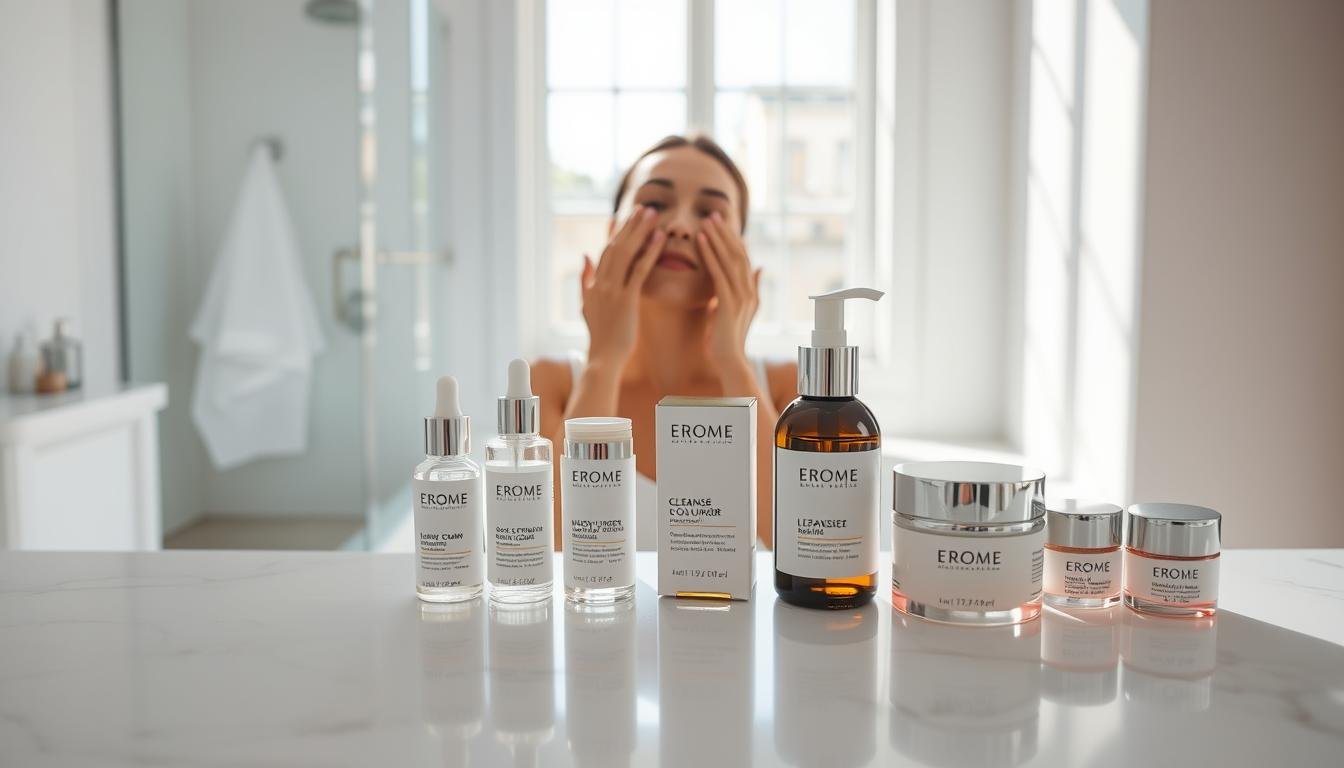Taking care of your skin is essential for maintaining its health and radiance. A well-planned skincare routine can make all the difference, whether it’s for energizing your complexion or repairing daily damage. But how do you ensure your regimen is effective?
Experts agree that the order of product application matters. Layering from the lightest to the heaviest ensures maximum absorption and benefits. Choosing the right products for specific times of the day is equally important.
This guide will walk you through the steps of a complete routine, from cleansing to applying sunscreen and specialized treatments. Whether you’re starting your day or winding down, these tips will help you achieve glowing, healthy skin.
Understanding the Importance of Consistent Skincare Routines
Maintaining a consistent approach to skin health can transform your complexion. A regular regimen not only cleanses but also shields your skin from environmental stressors. By sticking to a routine, you can protect your skin from dirt, pollution, and other damaging factors.

Benefits of a Regular Routine for Skin Health
Consistency in your daily habits ensures that your skin stays healthy and resilient. Regular cleansing removes dirt and impurities, preventing clogged pores and breakouts. Adding antioxidant-rich products can further reduce signs of damage and boost your skin’s natural repair process.
Dermatologists emphasize that a steady routine offers long-term protection. It helps maintain your skin’s barrier, keeping it hydrated and balanced. Over time, this can lead to a more even tone and a youthful glow.
How Daily Habits Impact Your Complexion
Your daily habits play a significant role in your skin’s appearance. Proper cleansing, for example, ensures that your skin is free from buildup. This allows other products, like moisturizers and serums, to penetrate effectively.
Here’s a quick breakdown of how daily habits contribute to a healthier complexion:
| Habit | Benefit |
|---|---|
| Cleansing | Removes dirt and impurities |
| Using Antioxidants | Reduces damage and boosts repair |
| Moisturizing | Keeps skin hydrated and balanced |
By incorporating these habits into your daily routine, you can achieve a healthier, more radiant complexion. Consistency is the key to unlocking your skin’s full potential.
Morning Skincare Routine: Prep Your Skin for the Day
Starting your day with a fresh face sets the tone for everything else. A simple yet effective routine can help your skin look and feel its best. Let’s break down the essential steps to prep your skin for the day ahead.

Cleansing and Toning: A Fresh Start
Begin with a gentle cleanser to remove overnight buildup. Use lukewarm water and apply the product in circular motions. This ensures your skin is free from oils and impurities, leaving it clean and refreshed.
Next, apply a toner to rebalance your skin’s pH. Use a cotton pad for even application. This step preps your skin for the hydrating products that follow, ensuring better absorption.
Hydration and Protection: Moisturizer and Sunscreen Essentials
After toning, use a lightweight, hydrating moisturizer. This locks in moisture and creates a smooth base for makeup. Look for formulas that suit your skin type for optimal results.
Finally, never skip sunscreen. It’s your best defense against sun damage. Apply it generously to protect your skin throughout the day. This step is non-negotiable for maintaining healthy, radiant skin.
Night Skincare Routine: Repair and Rejuvenate
Your evening regimen is the perfect time to focus on repair and renewal. After a long day, your skin needs extra care to recover from environmental stressors and daily wear. A well-planned nighttime routine can help restore balance and promote a healthy, glowing complexion.
Double Cleansing for Deep Makeup and Dirt Removal
Start with an oil-based cleanser to dissolve makeup, sunscreen, and impurities. This step ensures thorough removal of buildup, which can clog pores and dull your complexion. Follow with a water-based cleanser to eliminate any remaining residue.
Double cleansing not only removes makeup but also preps your skin for better absorption of treatments. Dermatologists recommend this method for its effectiveness in maintaining clear, healthy skin.
Serums, Treatments, and Night Cream for Overnight Renewal
After cleansing, apply a targeted serum to address specific concerns. Ingredients like hyaluronic acid and peptides work to hydrate and repair while you sleep. These potent formulas penetrate deeply, enhancing your skin’s natural renewal process.
Finish with a rich night cream to lock in moisture and nutrients. Look for formulas with antioxidants or retinol to boost collagen production and reduce signs of aging. This final step ensures your skin wakes up refreshed and rejuvenated.
Here’s a quick guide to the ideal nighttime routine:
- Use an oil-based cleanser to remove makeup and impurities.
- Follow with a water-based cleanser for a thorough cleanse.
- Apply a hydrating or reparative serum.
- Seal everything in with a nourishing night cream.
By following these steps, you can maximize your skin’s overnight repair process. Consistency is key to achieving long-term results and maintaining a radiant complexion.
How to Layer Your Skincare Products Effectively
The order in which you apply your products impacts their effectiveness. Layering from the thinnest to the thickest ensures each ingredient penetrates properly. This method allows your skin to absorb the active components fully, maximizing their benefits.
Step-by-Step Guide to Proper Layering
Start with the lightest formulas, like toners or essences. These products are water-based and absorb quickly. Next, apply serums or treatments. These are packed with active ingredients that target specific concerns, such as hydration or brightening.
Follow with moisturizers or creams. These thicker formulas lock in moisture and create a protective barrier. Finally, use oils or balms. These seal everything in, ensuring your skin stays hydrated and nourished.
Understanding the Thin-to-Thick Application Rule
The thin-to-thick rule is essential for optimal absorption. Lighter products, like toners, prep your skin for heavier ones. Thicker formulas, such as creams, act as a barrier, preventing moisture loss.
Here’s a quick breakdown of the layering process:
| Step | Product Type | Purpose |
|---|---|---|
| 1 | Toner/Essence | Prep and hydrate |
| 2 | Serum/Treatment | Target specific concerns |
| 3 | Moisturizer/Cream | Lock in moisture |
| 4 | Oil/Balm | Seal and protect |
Timing is also crucial. Wait a minute or two between each step to allow the product to absorb fully. This ensures each layer works effectively without interfering with the next.
By following these guidelines, you can create a routine that maximizes the benefits of every product. Proper layering makes a noticeable difference in your skin’s health and appearance.
skincare Morning or night routines: Choosing What Suits Your Skin Type
Understanding your unique skin needs is the first step to a glowing complexion. Your skin type determines which products and routines will work best for you. Whether you have dry skin, oily skin, or a combination, tailoring your approach ensures optimal results.
Identifying Your Skin Type and Concerns
Determining your skin type is essential for building an effective routine. Dry skin often feels tight and may flake, while oily skin tends to look shiny and is prone to breakouts. Combination skin has both dry and oily areas, usually an oily T-zone and dry cheeks.
Common concerns like acne or sensitivity also influence your product choices. For example, those with acne-prone skin should look for non-comedogenic formulas. Sensitive skin benefits from fragrance-free and hypoallergenic products.
Here’s a simple way to identify your skin type:
- Wash your face and wait an hour without applying any products.
- If your skin feels tight or dry, you likely have dry skin.
- If it appears shiny, especially in the T-zone, you have oily skin.
- If both conditions apply, you have combination skin.
Pay attention to how your skin reacts over time. Adjust your routine based on seasonal changes or new concerns. For instance, colder months may require richer moisturizers for dry skin, while summer calls for lighter formulas for oily skin.
By understanding your skin type and addressing specific concerns, you can create a routine that truly works for you. For more insights on how societal pressures can influence skincare choices, read about the impact of skin-whitening products.
Tailoring Your Routine for Specific Skin Concerns
Your skin’s unique needs require a customized approach for optimal results. Whether you’re dealing with acne, dryness, or excess oil, targeted treatments can make a significant difference. Let’s explore how to adjust your routine to address these common concerns effectively.
Dealing with Acne, Dryness, and Excess Oil
For acne-prone skin, consistency is key. Use a gentle cleanser to remove impurities without stripping your face of essential moisture. Incorporate products with salicylic acid or benzoyl peroxide to target breakouts. Avoid over-cleansing, as it can trigger more oil production.
Dry skin benefits from rich, hydrating formulas. Look for a moisturizer with hyaluronic acid or ceramides to lock in moisture. Layering a hydrating serum under your moisturizer can also boost hydration levels.
If excess oil is your concern, opt for lightweight, non-comedogenic products. A balancing toner with witch hazel can help control shine without over-drying. Remember, even oily skin needs hydration—choose a moisturizer designed for your skin type.
Here are some practical tips for managing these concerns:
- Use spot treatments for targeted acne care.
- Exfoliate 1-2 times a week to remove dead skin cells.
- Adjust your routine seasonally to meet changing needs.
For more insights on adapting your routine for different seasons, check out this guide on summer skincare routines.
By tailoring your routine to your specific concerns, you can achieve a healthier, more balanced complexion. Consistency and the right products are your best allies in this journey.
Essential Ingredients and Their Role in Your Routine
The right ingredients can transform your skin, making it healthier and more radiant. Understanding the role of active components like acids, antioxidants, and hydrators is key to building an effective routine. These ingredients work together to address specific concerns and enhance your skin’s natural processes.
Antioxidants, Acids, and Hydrators: What to Look For
Acids, such as glycolic or salicylic acid, are essential for promoting cell turnover. They help remove dead skin cells, unclog pores, and reveal a smoother complexion. Antioxidants, like vitamin C, protect your skin from environmental damage during the day. They neutralize free radicals, reducing signs of aging and boosting overall health.
Hydrators, such as hyaluronic acid, lock in moisture and keep your skin plump and supple. These ingredients are especially important for maintaining a balanced complexion, regardless of your skin type.
Selecting the Right Active Ingredients for Your Needs
Choosing the right ingredients depends on your specific concerns. For example, a nighttime skincare routine often includes retinol, which promotes skin renewal and repair while you sleep. If you’re targeting signs of aging, an eye cream with peptides can help reduce fine lines and puffiness.
For daytime protection, look for products with SPF to shield your skin from the sun. Combining these ingredients thoughtfully ensures your routine addresses both immediate and long-term needs.
| Ingredient | Benefit |
|---|---|
| Acids (e.g., glycolic, salicylic) | Promote cell turnover, unclog pores |
| Antioxidants (e.g., vitamin C) | Protect against environmental damage |
| Hydrators (e.g., hyaluronic acid) | Lock in moisture, maintain hydration |
| Retinol | Promote skin renewal and repair |
| Peptides | Reduce fine lines and puffiness |
By understanding these ingredients and their benefits, you can create a routine that works for your unique needs. Whether it’s protection during the day or repair at night, the right choices make all the difference.
Conclusion
Achieving a glowing complexion requires a balanced approach to daily habits. Consistency is key—whether you’re cleansing, moisturizing, or applying treatments, sticking to a routine ensures your skin stays healthy and radiant.
Proper layering techniques, like starting with lightweight products and finishing with richer formulas, maximize absorption. Customizing your regimen to address specific concerns, such as dryness or sensitivity, further enhances results.
Don’t overlook the importance of nighttime care. Using oil-based cleansers and targeted treatments helps repair daily damage while you sleep. Pay special attention to the eye area, as gentle application can reduce puffiness and fine lines.
Take a moment to evaluate your current habits. Adjust based on your unique needs and enjoy the journey of discovering what works best for you. Your skin deserves the care and attention it needs to thrive.

